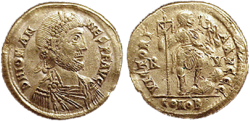Joannes
| Joannes | |
(c) Classical Numismatic Group, Inc. http://www.cngcoins.com, CC BY-SA 3.0 | |
| Född | Aquileia, Italien |
|---|---|
| Död | Aquileia, Italien |
| Medborgare i | Romerska riket |
| Sysselsättning | Politiker |
| Befattning | |
| Romersk senator Konsul | |
| Redigera Wikidata | |
Joannes (latin Ioannes), död 425, var en romersk usurpator (423–425) mot Valentinianus III.
Efter kejsar Honorius död den 27 augusti 423,[1] kvarstod Theodosius II vid makten som den östliga kejsaren och representant för Theodosiusdynastin. Nominellt var han härskare för hela det romerska riket. Under de första månaderna gjorde han emellertid lite för att befästa sin kontroll över den västra delen, vilket utnyttjades av höga civila tjänstemän för att utropa Joannes till kejsare av den västliga delen utan att chefen för armén general Castino motsatte sig det.[1]
Thedosius II sände en armé mot Joannes och avsatte honom, samt gav makten till Valentinianus III som då var ett barn. Joannes dömdes till döden och avrättades 425.[1]
Noter
- ^ [a b c] ”Ancient History Sourcebook” (på engelska). Procopius, History of the Wars (ca 550). New York: Fordham University. https://sourcebooks.fordham.edu/ancient/procopius-vandals.asp. Läst 4 juli 2024.
Media som används på denna webbplats
(c) Classical Numismatic Group, Inc. http://www.cngcoins.com, CC BY-SA 3.0
Joannes. 423-425 AD. AV Solidus (4.36 gm). Ravenna mint.
- D N IOHANNES PF AVG, rosette-diademed bust right
- VICTORIA AVGGG, Emperor standing right, holding Victory, Labarum, foot on captive, R-V, CONOB.
RIC X 1901 (R2); Depeyrot 12/1.
- Little is known of the origin and early career of Johannes (John), but at the time of the death of the western Emperor Honorius (August 15, 423 AD) he occupied a position of great influence as head of the palace bureaucracy in Ravenna. An ‘interregum’ of several months followed Honorius' death during which the eastern Emperor Theodosius II (402-450) was technically the ruler of the entire Empire. On 20 November the situation was dramatically changed by the proclamation of Johannes in Ravenna as emperor of the West. Theodosius refused to countenance this usurpation and decided to support the claim to the western throne of his young cousin, Valentinian, son of the late Emperor Constantius III and the Empress Galla Placidia. Towards the end of 424 a large army was despatched from the East with orders to remove Johannes from power and to install Valentinian III as emperor of the West. After various setbacks this task was accomplished and the unfortunate Johannes was taken prisoner in Ravenna and sent to Aquileia for execution. his reign had lasted little more than a year and a half.
- The rare coinage of Johannes was issued mostly from his capital of Ravenna where at least five denominations were produced. This attractive solidus is of the usual ‘western’ design, with a profile bust of the emperor on obverse and his standing figure spurning a barbarian captive on reverse. The portrait depicts the emperor bearded, an unusual feature at this time and one which was sometimes associated with pagan sympathies.
Författare/Upphovsman: Ssolbergj, Licens: CC BY 3.0
Vexillum of the Roman Empire.



